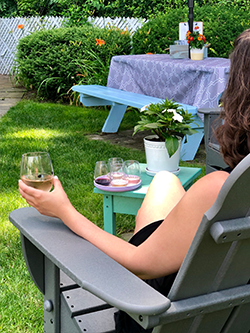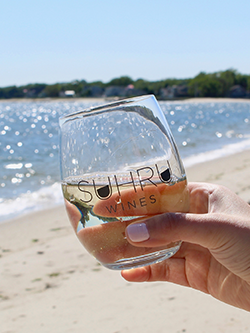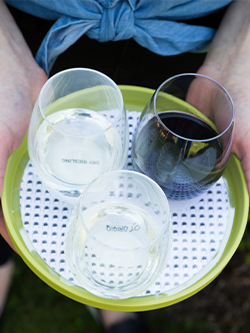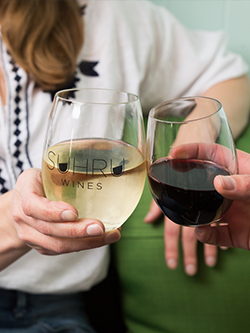Wine Tasting 101
 If you're planing a trip to wine country or simply tasting wines at home there are a number of helpful hints, tips, and tricks to ensure you get the most out of your tasting experience however one of our favorite (and the easiest to remember) is the 5 S's—Sight, Swirl, Sniff, Sip, Savor (or Spit, that's up to you).
If you're planing a trip to wine country or simply tasting wines at home there are a number of helpful hints, tips, and tricks to ensure you get the most out of your tasting experience however one of our favorite (and the easiest to remember) is the 5 S's—Sight, Swirl, Sniff, Sip, Savor (or Spit, that's up to you).
Sight
When it comes to tasting we all assume that our tongue is the main muscle we're flexing and while it is the main one, there is more to tasting than just "taste". Your sense of sight can tell you a lot about the wine before it even reaches your lips. Once the wine has been poured into your glass take a look at it, what do you notice? Right off the bat you should be able to tell first and foremost is it a white, red, or rosé wine? Is it still or sparkling?
Place your glass over a white surface and examine the color. Is it pale and translucent or rich and opaque? If it is a red wine, is the color consistent or do you see some browning on the edges? All of these characteristics and more will allow you to start to assess the wine in the glass, make certain observations and conclusions, and get a better sense of what the wine will taste like.
The color of a wine can tell you a lot about the wine in the glass. If a white wine is lighter in color it is likely stainless steel fermented and on the drier side whereas a honey hue in a white wine is often the sign of barrel aging or the presence of more residual sugar. If you are looking at a red wine similar observations can be made, often lighter bodied wines will be paler in color leaning more towards the red side of the color spectrum whereas fuller bodied reds with more tannic structure will be deeper and often more opaque in color.
 Swirl
Swirl
An often overlooked step in the tasting process, swirling a wine in your glass has several meaningful results (other than just making you look fancy!). Swirling a wine in the glass exposes it to oxygen. While we often talk about oxygen in relation to wine as a negative (think wine turning into vinegar) controlled oxidation allows the flavors and aromatics to open up. By swirling a wine in the glass you are increasing the surface area of the wine and exposing more of the wine to oxygen, similar to the process taking place when a wine is decanted. As you swirl you'll start to notice more aromatics being release.
Pro Tip: Hold your glass by the stem or bottom of the bulb (if using stemless) and slowly rotate your wrist to move the wine around the edges of the glass. The swirl is all in the wrist, people often incorporate the whole arm into this movement which can lead to wine sloshing over the rim of the glass, which no-one wants.
Sniff
 Your sense of smell and your sense of taste are very closely related, as your nose and throat connect to the same airway. Which for example, is why when you have a cold and a stuffy nose, your sense of taste is diminished. Smelling a wine in the glass is a good first step in assessing the flavor profile of the wine. Stick your nose as far into the glass as you can and take a deep inhale, what do you smell? Notice the fruit notes. In a white wine, do you notice tropical and stone fruits or more citrus? For a red wine, do you detect red (raspberry, red currant, strawberry, red cherry) fruit notes or more on the black (blueberry, plum, blackberry, dark cherry, dark currant) fruit side of things? What about oak?
Your sense of smell and your sense of taste are very closely related, as your nose and throat connect to the same airway. Which for example, is why when you have a cold and a stuffy nose, your sense of taste is diminished. Smelling a wine in the glass is a good first step in assessing the flavor profile of the wine. Stick your nose as far into the glass as you can and take a deep inhale, what do you smell? Notice the fruit notes. In a white wine, do you notice tropical and stone fruits or more citrus? For a red wine, do you detect red (raspberry, red currant, strawberry, red cherry) fruit notes or more on the black (blueberry, plum, blackberry, dark cherry, dark currant) fruit side of things? What about oak?
Pro Tip: Whenever you are tasting you want to ensure that what you are smelling is coming from the glass, not from your surrounding environment. While perfume and scented lotions are all great, it is best to skip it on days you are tasting as the aromas from the perfume will influence what you and the people around you taste in the glass.
Sip
Now its time to taste! Give the glass one more nice swirl, take a deep inhale, and take a sip. Let the wine sit on the top of your tongue, move it around your mouth making sure it comes in contact with the roof of your mouth and the sides of your tongue. What do you notice? What flavors jump out to you? Do you find yourself salivating from the acidity? Are you experiencing any drying sensations in your mouth coming from the tannins? Take another sip, this time while holding the wine in your mouth pull a small amount of air across your tongue, swish the wine around, swallow, and with your mouth closed exhale through your nose? What additional flavors do you notice?
Pro Tip: When it comes to tasting your pallet is key. Avoid gum, coffee, or strongly flavored foods prior to tasting and never brush your teeth just before a tasting as the flavors will diminish your tasting abilities.
 Savor (or Spit)
Savor (or Spit)
This last and final step is everyone's favorite! You have reached the main event and now can enjoy the wine in your glass without having to worry about identifying flavors or characteristics. However the fun doesn't stop here. While you have reached the end of the S's there are plenty more ways to explore the wines you have in front of your the main one being combine the tasting experience with food.
One of the things we often forget when tasting wine is how those flavors interact on the palate once additional flavors are introduced which is why it is always best to taste a wine on its own as well as with food to see how the flavors change and evolve. Taste the wine in your glass with a meal, with a cheese or charcuterie spread at the Tasting House, or simply with a cracker and see how the flavor profile changes and evolves, happy sipping!
